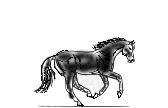An anecdote dealing with dry weather...
DEALING WITH DRY WEATHER.
There may be a few of us around who remember the drought of ‘52-‘53, but we prefer not to discuss it. The current dry spell has been persistent enough for us to see its effects on the health of our horses. The first health effect we usually think of when dealing with dry, dusty conditions is in the sinuses and lungs. These same conditions can also affect the eyes, haircoat, and feet. We will spend a little time on each.
Chronic dust in the environment will lead to irritation of the lungs. The resulting inflammation leaves the lungs more susceptible to infection and can lead to sinus infections and/or pneumonia. The usual sign of sinus infections is drainage from one or both sides of the nose. Occasionally we can hear the gurgling sound of air moving through swollen sinuses.
Pneumonia will make the horse feel worse and cause signs such as nasal drainage, coughing, lack of appetite, shallow breathing, and in general not feeling well. These conditions should be treated with antibiotics and supportive therapy. The treated horse usually responds well, depending on how early treatment is started.
The condition specifically related to dust is a chronic, debilitating disease called "heaves." Heaves of the horse is very similar to emphysema in people. The chronic inflammation of the lungs resulting from continuous exposure to dust results in swelling of the air pathways. This slows the movement of air through the lungs, depriving the horse of its oxygen. To compensate, the horse will actively draw air into the lungs. But as the air starts to escape, the swollen airways slows its movement. About this same time, Dobbin will draw more air in. As air accumulates within the alveoli (the small branches of airways within the lungs resembling a tree) it starts to stretch the surrounding tissue, which happens to be the outside of the lung! This stretching causes small tears of the lining. As these try to heal, they attach to the inside lining of the rib cage.
As this progresses, free movement of the lungs is severely limited. Now Dobbin must continually sruglle to draw air into his lungs to breathe, instead of the normal passive air movement as the lungs expand and contract independent of the ribs. After a few weeks of this activity, the muscles outlining the rib cage will start to grow and outline the ribs. This we call the ‘heave line.’ This oversimplified, long winded description will hopefully help you understand what happens in these horses. We certainly have seen more cases this fall than in several previous years put together.
One recent case was in the acute stage when presented. The mare did not have a heave line and when brought in appeared normal in spite of a long trailer ride. The history was that she was normal, until the grandkids spent a weekend riding along the country roads. Shortly thereafter, her breathing became noticeable. By the time the initial exam was completed, she was becoming anxious enough that we could hear her heavy breathing (and I had not even done the rectal exam for a pregnancy check!). By the time I was finished, we could hardly talk above the roaring of her breathing. As she left, breathing was so difficult she was unsteady in her walking. The owner was taking it better then the waiting clients and I. He said this was the way she would do when excited. A follow up call found that she was breathing almost normally at the half way stop on the way home.
At the follow up exam, the heave line was becoming obvious. The mare was breathing much better and had put on 50 pounds in the month since the first visit. This long winded account took up all our time, but I hope you found it interesting. Hopefully, by the time we continue this, the drought will only be an unpleasant memory.
CLICK BELOW TO DISPLAY A PRINTER-FRIENDLY COPY OF THIS ARTICLE
Select "Open this file from its current location," if you just want to print it out,
it will open in a simple word processing application, select the print button.
(unless you want to save this article in your computer's memory)

 DEALING_WITH_DRY_WEATHER.rtf
DEALING_WITH_DRY_WEATHER.rtf